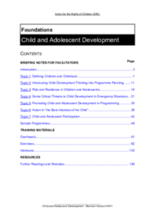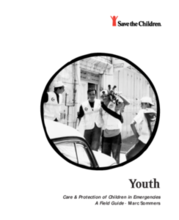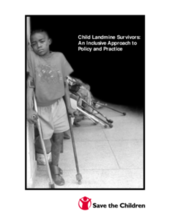Displaying 481 - 490 of 497
Outlines the planning and implementation of programs focused on recruitment prevention, demobilization, or reintegration of child soldiers. Includes notes on situation analysis, monitoring, and evaluation.
Outlines national efforts to disarm, demobilize, and reintegrate former child soldiers with respect to specific political contexts. Includes lessons learned, future challenges, and recommendations.
Resource pack for a course in child and adolescent development. Emphasis on identifying threats to childhood development and strategies to promote development in adverse conditions. Includes facilitators notes, participatory exercises, overheads, and handouts.
A report about a case-study in Rwanda documenting the practice of, and policies regarding, fostering (formal and informal). The study also explored the views of children in foster care, caretakers, agencies and local authorities regarding fostering.
This article seeks to draw attention to some of the issues affecting women detainees and the applicable international humanitarian standards which afford them protection and assistance.
Training materials on the threats to children’s development from displacement and armed conflict and other emergency situations. It includes guidance on strategies to promote children’s development in adverse conditions.
A training resource pack on skills for working effectively with children, particularly children in distress.
Discusses the importance, benefits and challenges to community mobilisation for refugees and other displaced persons, with a particular emphasis on children. Includes facilitators notes, participatory exercises, overheads, and handouts.
An overview of the key challenges surrounding youth in crisis and the framework for dealing with these issues based on Save the Children principles in youth programming. Includes detailed examination of international programming examples.
Guidance on principles and recommendations for work with children and adolescents who survive landmine injuries. Appendices include detailed lists of relevant resources.









